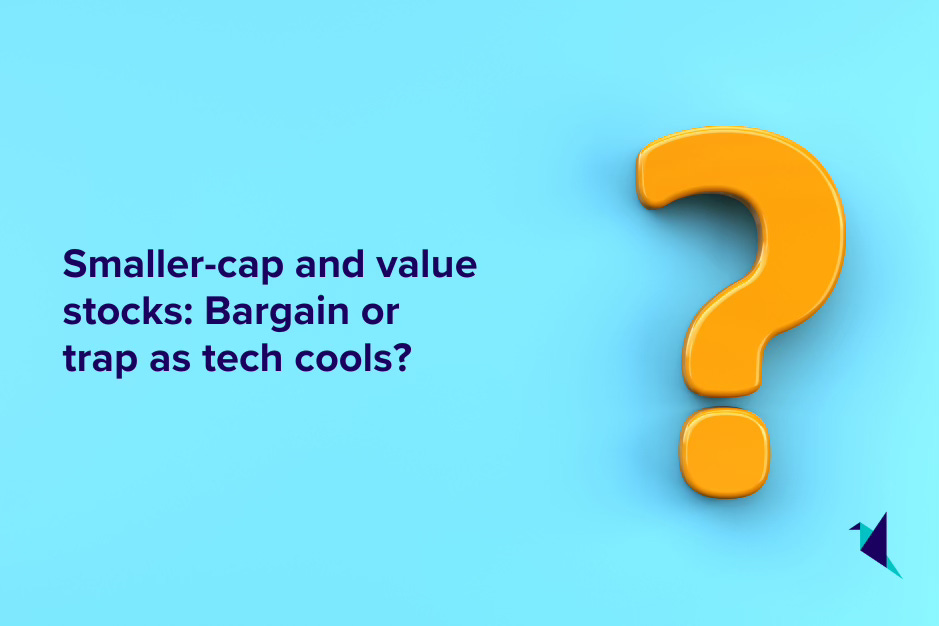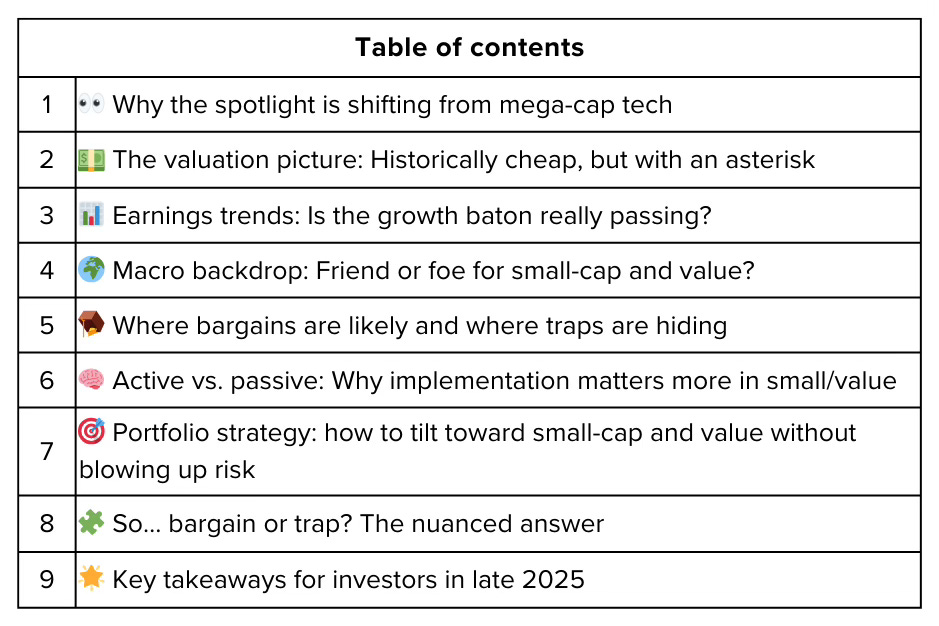Smaller-cap and value stocks: Bargain or trap as tech cools?
For the past few years, the market story has been dominated by mega-cap tech and the AI trade. Names like Apple , Microsoft , and NVIDIA led global indexes higher while most of the market quietly lagged behind. Now, with tech multiples stretched and bouts of volatility hitting growth leaders, attention is shifting back to smaller-cap and value stocks.
Are these laggards finally set up for a comeback, or are they cheap for good reasons? This article breaks down where small-cap and value valuations stand in late 2025, what the earnings and macro data say, and how investors can separate genuine bargains from value traps.
🔔 Don’t miss out!
Add winvestacrisps@substack.com to your email list so our updates never land in spam
Why the spotlight is shifting from mega-cap tech 👀
After a disappointing start to 2025, small caps have begun to quietly outperform large caps, especially since the first signs of sector rotation emerged in mid-year. Several forces are at work:
Tech consolidation: The “Magnificent 7” saw spectacular gains but now face profit-taking, regulation risk, and valuation fatigue.
Rate expectations: As the Fed edges closer to a full easing cycle, the higher sensitivity of small caps to borrowing costs suddenly looks like a tailwind, not a headwind.
Valuation gaps: Relative to large caps, small-cap and value indices are trading near multi-decade valuation discounts, enticing investors hunting for mean reversion.
The big question: does this shift represent the early stages of a durable leadership change—or just a short-term bounce in structurally weaker areas of the market?
The valuation picture: Historically cheap, but with an asterisk 💵
On almost any traditional metric, price-to-earnings, price-to-book, or enterprise value to cash flow, small caps and value stocks look cheap relative to large-cap growth:
U.S. small caps (S&P 600) are trading at a discount to their own long-term average and at some of the widest discounts ever versus the S&P 500.
Value indices (like Russell value segments) also sit near record-low relative valuations to growth-heavy benchmarks.
Equal-weight versions of the S&P 500 have underperformed cap-weighted versions for years, indicating that smaller constituents have lagged megacaps dramatically.
Valuation alone, however, is not a catalyst. Cheap can stay cheap—or even go cheaper—if fundamentals don’t improve.
Historically, small caps tend to outperform after:
Fed tightening cycles end and rate cuts begin;
Earnings growth for smaller companies starts to outpace that of large caps;
Markets turn from multiple expansion to earnings-driven leadership.
Some of those conditions are beginning to appear in the data—but not uniformly.
Earnings trends: Is the growth baton really passing? 📊
Recent research and outlooks suggest:
Small-cap earnings growth is finally narrowing the gap versus large caps after years of underperformance, with many strategists expecting small-cap EPS growth to exceed large caps into 2026.
Rising M&A activity and more accommodative regulation could boost profit outlooks for smaller and mid-sized firms.
At the same time, margins for many small caps remain more vulnerable to wage and input-cost pressures, and a sizable slice of small-cap indices still contain unprofitable or low-quality companies.
In value-land, the picture is similarly mixed:
Financials, industrials, and select cyclicals show improving earnings revisions, helped by higher-for-longer nominal rates and infrastructure spending.
Old-economy value traps—high-debt, low-growth, structurally disrupted businesses—still lurk beneath low multiples. Cheapness here is often a red flag, not a green light.
So while the earnings backdrop is getting better, investors have to be selective and quality-focused rather than blindly buying the “small and cheap” bucket.
Macro backdrop: Friend or foe for small-cap and value? 🌍
The macro environment in late 2025 is very different from the liquidity-fueled era that turbocharged big tech:
Rates: Policy rates appear near a peak with markets pricing staged cuts over the next 12–18 months—historically a sweet spot for small caps, which benefit from easier credit conditions.
Inflation: Moderating, but not dead. Moderate inflation has often favored value sectors (financials, energy, industrials) over expensive growth names.
Growth: The soft-landing narrative remains fragile. Slower but positive GDP growth tends to help domestically oriented small businesses more than globally exposed megacaps.
Positioning: After years of crowding into a narrow group of AI and tech leaders, positioning in small caps and deep value is relatively light—creating room for flows if sentiment shifts.
On paper, this set-up leans supportive of a rotation into smaller-cap and value equities—if the economy avoids a hard landing and credit doesn’t crack.
Where bargains are likely and where traps are hiding 🪤
Potential bargains
Profitable small caps with strong balance sheets
Companies with positive cash flow, manageable leverage, and clear competitive niches.
Benefit quickly from easing credit and broadening earnings cycles.
Value sectors with cyclical tailwinds
Industrials, select financials, energy infrastructure, and materials benefiting from capex, re-shoring, or infrastructure trends.
“Quality value”
Stocks that screen cheap but also show high return on equity, stable margins, and prudent capital allocation.
These often sit at the intersection of value and quality factors, historically strong entry points.
Smaller beneficiaries of AI adoption, not just enablers
Firms using AI to cut costs and boost margins rather than trying to sell AI infrastructure in a crowded field, as some studies suggest small companies are increasingly doing.
Likely traps
“Zombie” small caps
Firms that depend on constant refinancing, lack clear paths to profitability, or are structurally disrupted.
Vulnerable if credit spreads widen or growth slows further.
Deep value with no catalyst
Low P/E or P/B but tied to secularly declining industries (legacy media, structurally impaired retailers, outdated energy assets).
Low-quality indices and broad baskets
Some small-cap indices (e.g., broad universes like the Russell 2000) contain a high share of unprofitable, speculative names.
Here, “buying the index” can mean owning a lot of junk alongside the gems.
Active vs. passive: Why implementation matters more in small/value 🧠
With large caps, broad index exposure often works well; market-cap-weighted exposure to leaders like the S&P 500 captured massive gains during the tech/AI boom.
In small caps and value, though, the dispersion between winners and losers is much greater, and index quality varies widely. That makes:
Active selection (fund managers, stock pickers) more valuable for excluding unprofitable or structurally broken businesses.
Smart beta and quality screens especially important (e.g., small-cap quality, small-cap value with profitability filters).
Equal-weight or factor ETFs potentially more attractive than plain-vanilla cap-weighted small-cap funds, which can be skewed by many low-quality microcaps.
In other words: in the small/value space, how you get exposure can be as important as whether you get exposure at all.
Portfolio strategy: how to tilt toward small-cap and value without blowing up risk 🎯
If you believe we’re in the early stages of a rotation away from stretched tech and toward smaller/value names, consider:
Incremental tilts, not all-in bets
Add 5–15% of equity exposure toward small-cap or value strategies rather than flipping your entire portfolio.
Blend growth, quality, and value
Avoid barbell extremes. Combining factors (e.g., small-cap quality value) can improve risk-adjusted returns.
Favor quality screens
Insist on minimum profitability, reasonable leverage, and cash-flow health.
Use both domestic and international exposure
Cheap small caps exist outside the U.S. as well; some international markets are further along in the value cycle.
Watch liquidity and position size
Individual small caps can be illiquid and volatile. Prefer funds or smaller positions to manage single-name risk.
Rebalance and be patient
Historical small-cap/value cycles can run for years—but also require tolerance for higher volatility and interim drawdowns.
So… bargain or trap? The nuanced answer 🧩
Bargain case:
Valuations vs. large caps look compelling by historical standards.
Earnings growth trends for quality small caps are improving.
Macro conditions (peak rates, stable growth) support a catch-up phase.
Positioning is light, leaving room for capital to rotate into the segment.
Trap case:
Index quality is weak in many popular benchmarks, with a high share of unprofitable firms.
Some “cheap” stocks are value traps tied to structurally declining business models.
If growth slows more than expected or credit tightens, small caps could underperform sharply again.
The reality is that smaller-cap and value stocks are neither uniformly cheap bargains nor across-the-board traps. They represent a wider opportunity set where selectivity, quality focus, and implementation make all the difference.
Key takeaways for investors in late 2025 🌟
The cool-off in mega-cap tech and AI has reopened the conversation about smaller-cap and value stocks as potential sources of future outperformance.
On relative valuation measures, quality small caps and many value sectors look historically attractive—but need earnings follow-through.
The macro backdrop (plateauing rates, moderate growth, rotation away from narrow leadership) favors a partial shift into this space, not a wholesale regime change just yet.
Avoiding overlap, emphasizing quality, and choosing the right vehicles (active managers, smart beta, or curated funds) is critical to avoid value traps.
For investors, the smarter question isn’t “Are small caps and value a bargain or trap?” but rather:
“How can I systematically gain exposure to the best parts of small and value while minimizing exposure to structurally weak names?”
Answer that well, and the cooling of tech leadership could turn from a headwind into one of the most attractive opportunities of the coming cycle.
Poll 📊
🚀 Join 60,000+ investors—become a paying subscriber or download the Winvesta app and fund your account to get insights like this for free!
Disclaimer: This article is for informational purposes only and does not constitute investment advice. Always conduct your own research and consider seeking professional financial advice before making any investment decisions.







